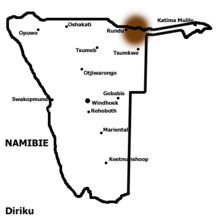lingvo.wikisort.org - Language
Gciriku or Dciriku (Also Diriku, Dirico, Manyo or Rumanyo), is a Bantu language spoken by 305,000 people along the Okavango River in Namibia, Botswana and Angola. 24,000 people speak Gciriku in Angola, according to Ethnologue.[3] It was first known in the west via the Vagciriku, who had migrated from the main Vamanyo area and spoke Rugciriku, a dialect of Rumanyo. The name Gciriku (Dciriku, Diriku) remains common in the literature, but within Namibia the name Rumanyo has been revived.[4] The Mbogedu dialect is extinct; Maho (2009) lists it as a distinct language, and notes that the names 'Manyo' and 'Rumanyo' are inappropriate for it.
| Dciriku | |
|---|---|
| Gciriku | |
| Rumanyo | |
| Region | Okavango River |
| Ethnicity | Vagciriku, Vamanyo, Vashambyu |
Native speakers | (undated figure of 36,000)[1] |
Language family | Niger–Congo?
|
| Dialects |
|
| Language codes | |
| ISO 639-3 | diu |
| Glottolog | diri1252 |
K.331,334 (K.332)[2] | |
 | |
It is one of several Bantu languages of the Okavango which have click consonants, as in [ǀɛ́ǀˀà] ('bed'), IPA: [mùǀûkò] ('flower'), and IPA: [kàǀûrù] ('tortoise'). These clicks, of which there are half a dozen (c, gc, ch, and prenasalized nc and nch), are generally all pronounced with a dental articulation, but there is broad variation between speakers. They are especially common in place names and in words for features of the landscape, reflecting their sources in Khwe and Ju, two members of the Khoisan language family. Many of the click words in Gciriku, including those in native Bantu vocabulary, are shared with Kwangali, Mbukushu, and Fwe.[5]
References
- Dciriku at Ethnologue (16th ed., 2009)
- Jouni Filip Maho, 2009. New Updated Guthrie List Online
- "Angola". Ethnologue. Retrieved 2019-07-19.
- Nordic journal of African studies, Volume 12, 2003
- Gunnink, Hilde; Sands, Bonny; Pakendorf, Brigitte; Bostoen, Koen (1 December 2015). "Prehistoric language contact in the Kavango-Zambezi transfrontier area: Khoisan influence on southwestern Bantu languages". Journal of African Languages and Linguistics. 36 (2): 193–232.
External links
На других языках
- [en] Dciriku language
[ru] Дирику (язык)
Дирику, (Diriku, Diriko, Dciriku, Gciriku, Manyo, Rumanyo, Mbogedo, Mbogedu, Rugciriku, Shimbogedu) — язык банту, на котором говорят народы вадирику, ваманьо, вашамбю в провинции Окаванго в Намибии, на юго-восточной границе с Намибией в провинции Кванду-Кубанго в Анголе, а также в Ботсване. Язык дирику был впервые известен на западе через народ вадирику, которые переселились из главной территории Ваманьо и разговаривали на рудирику (диалект языка руманьо). Название Gciriku (Dciriku, Diriku) остаётся распространённым явлением в литературе, но в Намибии название руманьо (Rumanyo) возродилось. Диалект мбогеду вымер; Махо (2009) перечисляет мбогеду в качестве отдельного языка и отмечает названия «маньо» (Manyo) и «руманьо» (Rumanyo), подходящие для этого.Другой контент может иметь иную лицензию. Перед использованием материалов сайта WikiSort.org внимательно изучите правила лицензирования конкретных элементов наполнения сайта.
WikiSort.org - проект по пересортировке и дополнению контента Википедии